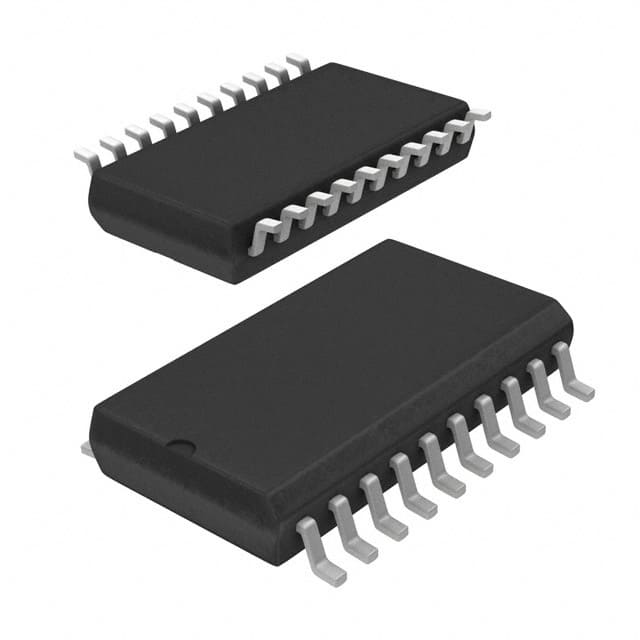SN74LVC245ADWR
Overview
- Category: Integrated Circuit
- Use: Level Shifter/Transceiver
- Characteristics: Bi-directional, 8-bit, voltage level translation
- Package: SOIC (Small Outline Integrated Circuit)
- Essence: Transfers data between different voltage domains
- Packaging/Quantity: Tape and Reel, 2500 pieces per reel
Specifications
- Supply Voltage Range: 1.65V to 5.5V
- High-Level Input Voltage: 2V to VCC + 0.5V
- Low-Level Input Voltage: -0.5V to 0.8V
- High-Level Output Voltage: VCC - 0.4V to VCC + 0.5V
- Low-Level Output Voltage: -0.4V to 0.4V
- Maximum Operating Frequency: 100MHz
- Number of Channels: 8
Pin Configuration
The SN74LVC245ADWR has a total of 20 pins. The pin configuration is as follows:
- DIR (Direction Control)
- OE (Output Enable)
- A1 (Input/Output Port A, Bit 1)
- A2 (Input/Output Port A, Bit 2)
- A3 (Input/Output Port A, Bit 3)
- A4 (Input/Output Port A, Bit 4)
- A5 (Input/Output Port A, Bit 5)
- A6 (Input/Output Port A, Bit 6)
- A7 (Input/Output Port A, Bit 7)
- A8 (Input/Output Port A, Bit 8)
- GND (Ground)
- B8 (Input/Output Port B, Bit 8)
- B7 (Input/Output Port B, Bit 7)
- B6 (Input/Output Port B, Bit 6)
- B5 (Input/Output Port B, Bit 5)
- B4 (Input/Output Port B, Bit 4)
- B3 (Input/Output Port B, Bit 3)
- B2 (Input/Output Port B, Bit 2)
- B1 (Input/Output Port B, Bit 1)
- VCC (Supply Voltage)
Functional Features
- Bi-directional data transfer between two voltage domains
- Automatic direction control based on DIR pin
- Output enable/disable control using OE pin
- Supports voltage level translation from 1.65V to 5.5V
Advantages and Disadvantages
Advantages: - Allows communication between devices operating at different voltage levels - Easy to use with automatic direction control - High-speed operation up to 100MHz - Wide supply voltage range for compatibility
Disadvantages: - Limited to 8-bit data transfer - Not suitable for applications requiring higher channel count
Working Principles
The SN74LVC245ADWR is a bidirectional level shifter/transceiver that enables data transfer between two voltage domains. The direction of data flow is controlled by the DIR pin. When DIR is high, data is transferred from Port A to Port B, and when DIR is low, data is transferred from Port B to Port A.
The OE pin is used to enable or disable the outputs. When OE is low, the outputs are enabled, allowing data transfer. When OE is high, the outputs are disabled, isolating the input and output ports.
The device uses internal circuitry to translate the voltage levels between the two domains, ensuring proper signal integrity and compatibility.
Detailed Application Field Plans
The SN74LVC245ADWR is commonly used in various applications, including:
- Microcontroller interfacing with different voltage peripherals
- Communication between devices operating at different voltage levels
- Level shifting in mixed-voltage systems
- Data transfer between FPGA and external devices
- Interface conversion in industrial automation systems
Detailed and Complete Alternative Models
- SN74LVC244A: Octal buffer/line driver with 3-state outputs
- SN74LVC541A: Octal buffer/line driver with 3-state outputs and input protection diodes
- SN74LVC573A: Octal transparent D-type latch with 3-state outputs
- SN74LVC4245A: Octal dual-supply bus transceiver with configurable voltage translation
These alternative models offer similar functionality and can be used as replacements for the SN74LVC245ADWR in specific applications.
In conclusion, the SN74LVC245ADWR is a versatile integrated circuit that facilitates bi-directional data transfer between different voltage domains. With its automatic direction control and wide supply voltage range, it finds applications in various fields requiring
Senaraikan 10 soalan dan jawapan biasa yang berkaitan dengan aplikasi SN74LVC245ADWR dalam penyelesaian teknikal
Sure! Here are 10 common questions and answers related to the application of SN74LVC245ADWR:
Q: What is SN74LVC245ADWR? A: SN74LVC245ADWR is a bidirectional octal bus transceiver with 3-state outputs, commonly used for level shifting and voltage translation in digital systems.
Q: What is the operating voltage range of SN74LVC245ADWR? A: The operating voltage range is from 1.65V to 5.5V, making it compatible with a wide range of digital logic families.
Q: How many bidirectional channels does SN74LVC245ADWR have? A: SN74LVC245ADWR has 8 bidirectional channels, allowing for the simultaneous transmission of data in both directions.
Q: What is the maximum data transfer rate supported by SN74LVC245ADWR? A: SN74LVC245ADWR supports data transfer rates up to 100 Mbps, making it suitable for high-speed applications.
Q: Can SN74LVC245ADWR be used for level shifting between different voltage domains? A: Yes, SN74LVC245ADWR can be used for level shifting between voltage domains, as long as the voltage levels are within its operating range.
Q: Does SN74LVC245ADWR have built-in ESD protection? A: Yes, SN74LVC245ADWR has built-in ESD protection, which helps protect the device from electrostatic discharge events.
Q: Can SN74LVC245ADWR be used in mixed-voltage systems? A: Yes, SN74LVC245ADWR can be used in mixed-voltage systems, where different parts of the system operate at different voltage levels.
Q: What is the output drive strength of SN74LVC245ADWR? A: SN74LVC245ADWR has a typical output drive strength of ±24 mA, allowing it to drive relatively heavy loads.
Q: Can SN74LVC245ADWR be used for level shifting between TTL and CMOS logic? A: Yes, SN74LVC245ADWR can be used for level shifting between TTL (5V) and CMOS (3.3V) logic, as long as the voltage levels are within its operating range.
Q: Are there any application notes or reference designs available for SN74LVC245ADWR? A: Yes, Texas Instruments provides application notes and reference designs that showcase the use of SN74LVC245ADWR in various technical solutions. These resources can be found on their website or obtained from their technical support team.
Please note that these answers are general and may vary depending on specific design requirements and application scenarios. It's always recommended to refer to the device datasheet and consult with the manufacturer for detailed information.


